New England’s Ends
WENDY BELLION
PROGNOSTICATION is a notoriously tricky affair. Unlike fortune-tellers, scholars have no crystal balls into which to gaze. We cannot rely upon tarot cards to predict the next big idea; nor can we use our palms to map lines of future research. It is all the more lucky for us, then, that New England studies already show discernible signs of new developments. One important shift involves an expansion of scope and methodologies: embracing the possibilities of Atlantic world scholarship, historians of visual and material culture are exploring the global as well as local implications of objects produced and consumed within the geographical territory of early New England. This work is sharpening our understanding of the means by which portraitists and their sitters, to take just one example, fashioned identities out of paint in places as diverse as urban art studios and backcountry cabins, thereby participating—whether consciously or unwittingly—in the broad circulation of people and ideas and goods that constituted the British empire. At the same time, specialists in visual and material culture are increasingly engaging in cross-disciplinary dialogues, with literary scholars initiating studies of visual images and art historians interrogating the functions of words within printed images (not to mention words upon gravestones, textiles, and other objects). In the process, disciplinary notions of “visual culture” and “material culture” are proving noticeably elastic.
With this evidence of such changes already underway, where do we go from here? How might we begin to remap New England’s ends (in the double sense of New England’s geographical and cultural boundaries as well as the sorts of objectives we define for ourselves as scholars)? This essay offers some preliminary thoughts in response to these questions. It considers how interdisciplinary discourse, together with the evidentiary nature of early American objects, presents opportunities for reexamining the utility of the categorical descriptors “visual culture” and “material culture” for New England studies. In addition, it suggests that transnational (or rather, transcolonial) approaches to New England culture can be as conceptually productive as transatlantic methodologies. To elaborate upon these points, I offer some lessons learned from my own research on early New England: first, the interpretive challenges posed by an illusionistic spectacle called the “Invisible Lady”; second, the case study of a picture painted by the visiting Briton Joseph Blackburn; and third, the experience of designing and teaching a university seminar on colonial art across North America. For the purposes of this short essay, the latter example may be especially instructive, for in any predictions about the future of visual and material culture studies, the next generation of scholars must figure prominently.
By way of looking forward, it helps to begin by invoking an ocular figure from the past: the “Invisible Lady,” a multisensory entertainment that enjoyed extraordinary popularity in the United States during the earliest decades of the nineteenth century. A broadside from an 1804 exhibition in Wilmington, Delaware, helps elucidate the peculiar functions of this contraption (fig. 1). According to the lengthy text, the instrument housed an invisible woman, one who could laugh, sing, whisper, and breathe. Indeed, this spectral presence could even view and converse with the people in attendance, describing their appearance and actions. Because the agent of these interactions remained indiscernible, the exhibition purported to “so completely deceive the senses as to appear the effect of magic.” But if the Invisible Lady was an “inexplicable auricular and optical illusion,” it was also a device for undeceiving: the broadside tempted observers to discover how the deception worked, promising that, in the process, they would learn to detect the artifice of would-be imposters and discredit claims of supernatural activity.1 Contemporary illustrations of the Invisible Lady, which exposed the mechanics of the deception to view, help demonstrate precisely how this instrument functioned (fig. 2)2 Spectators encountered a decidedly odd-looking contraption upon entering the exhibition spaces of the Invisible Lady. In its most familiar form, the device was comprised of a glass ball surrounded by four trumpets. It was surrounded by a square railing about waist-high and surmounted by a network of wires culminating in a form evocative of a plumed crown.3 The cross-section view at the base of this engraving reveals how the machine was able to communicate vision and sound: a series of speaking tubes ran from the posts of the railing underneath the floor to a woman sequestered in a nearby closet. Seated behind a pianoforte (occasionally the exhibitions featured music), the woman leans to one side to peer through a hole in the wall. This, then, was how the Invisible Lady could see and chat with her visitors while remaining out of sight. Far from manifesting an actual immaterial presence, the spectacle drew upon the exhibitor’s old-fashioned cunning and mechanical know-how. The key to solving the puzzle of this clever illusion resided in seeing through the tactics of concealment that disguised a simple architecture of pipes and peepholes.
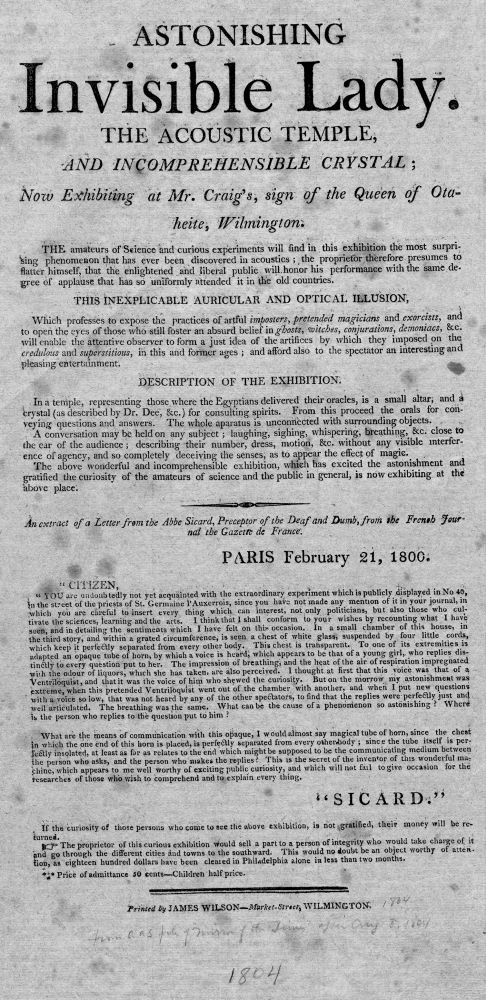
Fig. 1. “Astonishing Invisible Lady,” (Wilmington, De., 1804), broadside. Courtesy, American Antiquarian Society, Worcester, Mass.
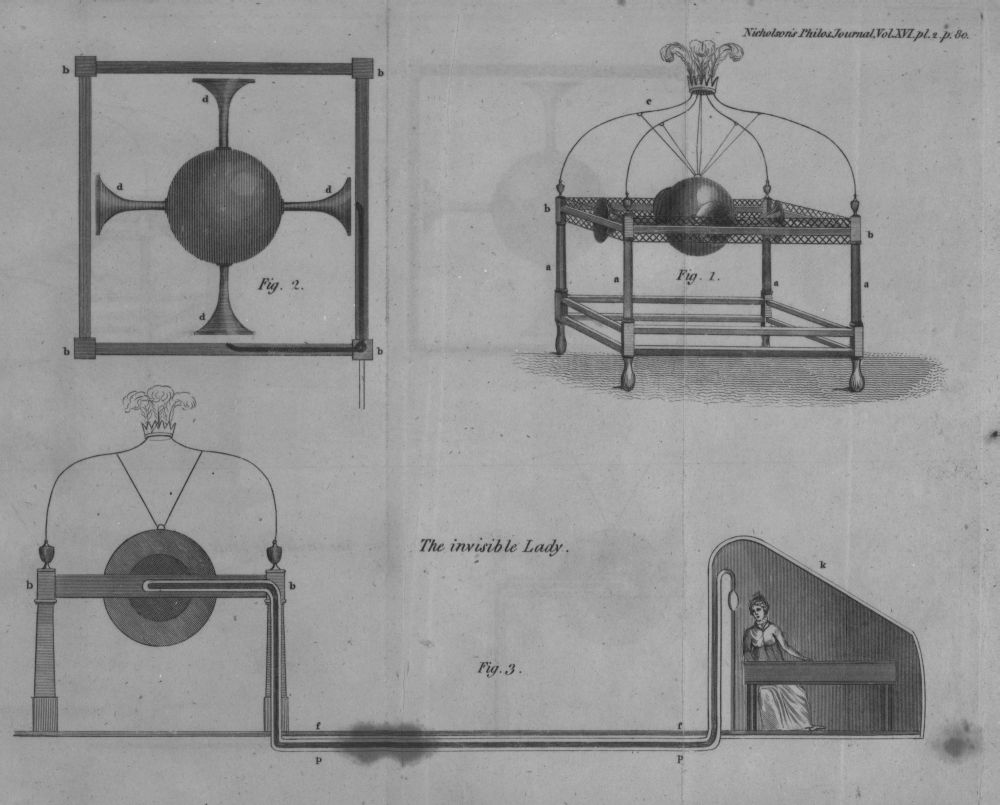
Fig. 2. The Invisible Lady. 1807. Engraving from the Journal of Natural Philosophy, Chemistry, and the Arts, XVI (1907), Plate 2, opposite 80. Courtesy, The Library Company of Philadelphia.
This proved to be both a stupefying and highly amusing challenge for the majority of the Invisible Lady’s visitors. According to advertisements documented in the America’s Historical Newspapers database, the Invisible Lady was displayed up and down the eastern seaboard dozens of times between 1800 and 1820, with a concentration of exhibitions occurring in 1804–05. During the fall of 1804, New Englanders got their chance to spot a glimpse of the elusive lady. Massachusetts hosted no less than four competing shows: one in Boston, another in Newburyport, and two in Salem. One of the latter shows prompted the publication of an exuberant woodcut in the Salem Gazette (fig. 3), an image that suggests a machine nearly alive with implied movement.4 Just a few months later, a Boston impresario named William Frederick Pinchbeck carefully detailed the operations of the instrument (fig. 4)5 In a lengthy discussion of the Invisible Lady, Pinchbeck proposed that the exhibition would work even better if two agents collaborated to perform the deception. One individual could observe the assembled spectators through a latticework hidden by a girandole, eavesdropping upon conversations and conveying information to his partner; the other would play the part of the Invisible Lady’s voice, returning answers to the spectators’ questions via the speaking tubes that snaked through the room. For the proprietor of the illusion, the use of two people would result in a better deception, for the speaking agent could be located at a greater distance from the exhibition room, thereby forestalling easy detection of the illusion’s mechanics. For the audience, on the other hand, this coordinated manipulation amounted to something potentially ominous: a conspiracy of sensory distraction as disconcerting as any of the ventriloquial deceptions imagined by the era’s leading author of Gothic narratives, Charles Brockden Brown.6
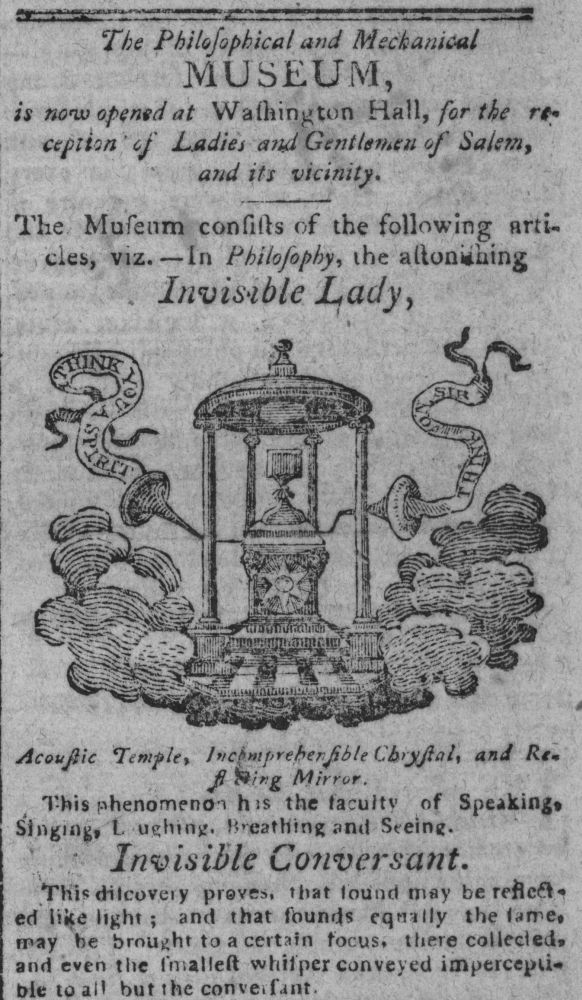
Fig. 3. “The Philosophical and Mechanical Museum, Is Now Opened . . . ,” Salem Gazette, Dec. 7, 1804, page 3, column 4. Courtesy of the Massachusetts Historical Society, Boston, Mass.
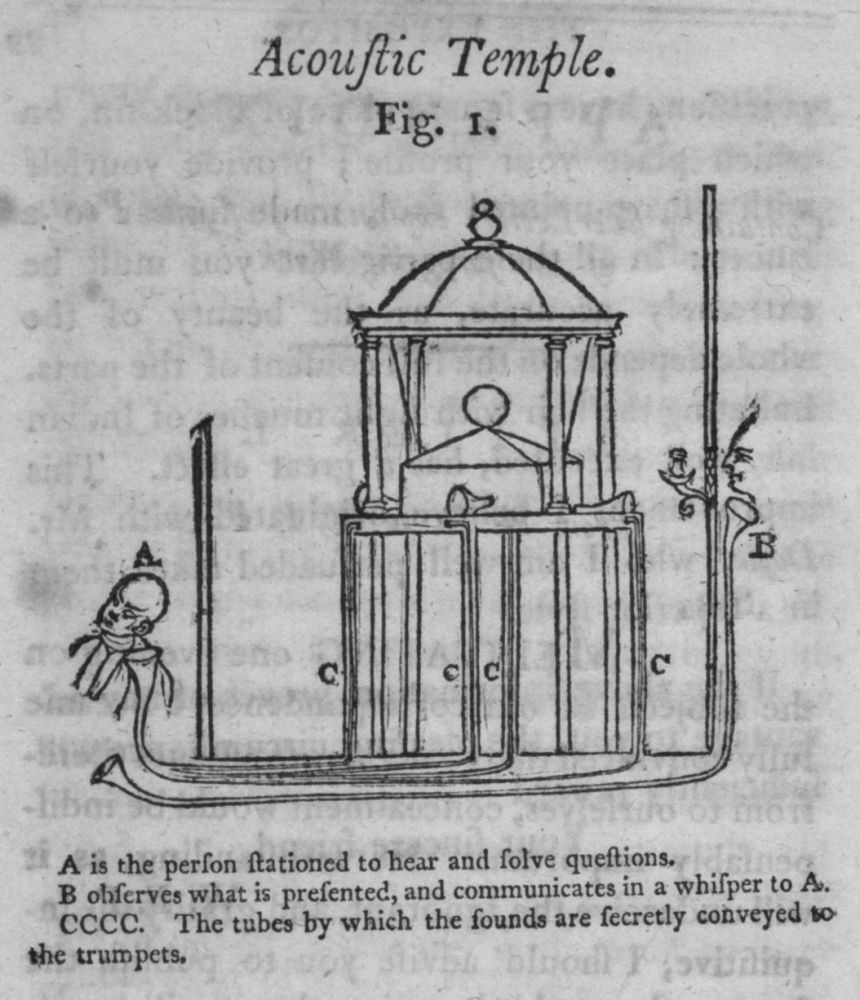
Fig. 4. “Acoustic Temple” and “Magnetic Penetrating Spy-Glass.” Relief print from William Pinchbeck, The Expositor; or, Many Mysteries Unravelled (Boston, 1805). Courtesy, American Antiquarian Society.
There is much more to say about the history of the Invisible Lady: about it how it became a trope of political deception during Jefferson’s administration; about how it modeled a female gaze only to invite the female viewer’s exposure; about how it posed an epistemological challenge to a republican society schooled in the Scottish philosophy of Common Sense. With regard to the specific issue of New England studies, though, the Invisible Lady helps raise questions about how we study New England’s past. Importantly, it tests familiar academic constructions of visual culture and material culture. As both a material object and an object of historical analysis, the Invisible Lady confounds any distinction we might attempt to draw between these fields of study. Its appeal was predicated upon the operations of what we would today call a Foucauldian “gaze,” the term that describes cultural systems wherein looking structures power, authority, and resistance. Yet the Invisible Lady realized these operations through its resolutely material form, a maze of trumpets and tubing that tempted people to run their hands along the square railing and take up the floorboards in exhibition rooms in an effort to learn how the deception functioned. Is this then an object of visual culture or an object of material culture? Or, if it belongs at once to both fields, how does it invite us to reckon with our understanding of these terms?
The answers to these questions are complicated by the fact that the disciplinary lines between visual culture, material culture, and related fields of study are not always firm or well-defined. Historically, visual culture has been aligned with the disciplines of art history and film studies. Whereas for some (such as historians of United States art) a primary value of this term resides in its challenge to the formation and content of disciplinary canons (a challenge which, in the case of American art history, posits that popular media as varied as lithographs, photographs, and advertisements shaped culture as much as fine paintings and sculptures), for others “visual culture” connotes broader ideas. “Visual culture” can describe a condition of western life—one defined by a global circulation of images and a modern episteme in which the visual organizes communication and experience. It can refer to the work of critical theory, in particular theory that explores the ways in which practices and ideologies of vision structure knowledge, representation, and subjectivity.7 The term “material culture” often implies something more eclectic, more expansive and object-driven. As practiced in anthropology, archeology, folklore, and cultural studies (material culture studies, as Victor Buchli has remarked, is less a singular discipline than “an intervention within and between disciplines”) material culture describes a mode of critical and historical analysis that gives equal due to theories of space and the forms of vernacular buildings, to the everyday stuff of consumer culture as well as the rarified texture of silk.8 Material culture examines the materiality of things, attending closely to issues of matter, shape, and style. At the same time, it concerns social practices and processes, asking how objects produce cultures, embody ideas, resist explication, and register loss.9 Operative within both visual and material culture studies is the understanding that different sorts of objects do different kinds of cultural work: that a piece of fabric, for example, raises questions distinct from those posed by a building or painting, and therefore requires a specific set of analytical tools. Such interests and concerns have served to help draw distinctions between the scholarly purviews of visual culture and material culture.
Yet as the example of the Invisible Lady suggests, visual culture implicates objects, and material culture involves vision. Moreover, the Invisible Lady is hardly the only object from New England’s past that evokes the fluid intersections of visual and material culture. As the essays gathered in this book demonstrate, scholarly research often defies easy categorization as “visual studies” or “material studies.” Indeed, the volume’s subtitle (Studies in Material and Visual Culture) implies a dialogue, or at least a complementary relation, between the two fields of study. Surely this enthusiasm for cross-disciplinary inquiry owes something to the influence of Margaretta Lovell’s recent book, Art in a Season of Revolution: Painters, Artisans, and Patrons in Early America (2004). Lovell’s expansive study deftly maps a creole Anglo culture in which objects as dissimilar as paintings, tables, and dresses formed part of an integrated world of goods, a world in which cultural meaning was produced through peoples’ encounters with both ordinary and extraordinary artifacts. Part of Lovell’s mission is to contest art-historical constructions of colonial aesthetic hierarchies (questioning, for instance, the semantic distinctions often drawn between “artist” and “artisan”) and to redirect our attention to the centrality of communities, families, and houses as the spheres in which a great majority of colonial objects were produced and consumed. The book achieves these objectives, notably, by drawing upon the methodologies of visual and material culture studies while refusing to explicitly align itself with only one or the other approach. Shifting the frame of analysis from disciplinary-specific interests to the “organic” nature of colonial “cultural life” enables Lovell to give equal due to the visual and tactile experiences of objects, to suggest how the same object (or a set of similar objects) can at once reveal cultural investments in “the value of optical . . . experience” and economic investments in a culture of finely-worked things.10 With this scholarly model at hand, no doubt the future will bring more efforts to integrate visual and material culture studies. Or, to put it differently, it will bring more efforts to understand how and why many early New England objects—by dint of their form or manufacture or use—signified visually and materially, thereby begging a nuanced approach from interpreters.
In interrogating the bounds of visual and material culture, we may also ask how these fields of study overlap with that of print culture. Here the Invisible Lady is once again instructive. Significantly, the only material traces of the exhibition survive in the form of printed artifacts: in broadsides, book illustrations, engravings, and newspapers. Moreover, the printed images of the instrument call attention to the fact that readers experienced this spectacle in ways fundamentally different than individuals at the actual show. In direct contrast to readers looking at printed illustrations of the illusion (see especially figs. 2 and 4), those present in the exhibition rooms employed senses other than, or in addition to, that of vision—including touch, hearing, and even smell—in their attempts to undeceive themselves of the deception of an Invisible Lady. Unlike readers, they were never privileged with the optical access and visual knowledge afforded by the printed cross-section view. Further, the many advertisements and exposés that circulated through early national newspapers suggest that the exhibition occasioned a widespread discourse about illusion. Print expanded the audience for the Invisible Lady, producing a viewership that was national in scope if wholly virtual in form.
What we have here is a historical instance of interdependent systems of knowledge production—but again, not a unique one. Many of the New England objects examined within this volume pose similar opportunities for exploring the endlessly fascinating relation of pictures and texts. By setting words and images side by side as historical evidence—by probing their interrelations instead of prioritizing one over the other—cultural historians not only engage in cross-disciplinary scholarship. They also come to terms with the mutuality of visuality and textuality. Puzzling through the codependency of images, texts, and objects equips us to better understand how print itself can function as a material artifact and space of looking.11
The geographical reach of print in early America, which literary historians have explored at length, raises a related question about the cohesion of New England as a discrete region of study. By the time the Salem Gazette print had appeared, the Invisible Lady had been exhibited in Philadelphia and New York. It was a sensation abroad in London and Paris, where it had originated in 1800. In the years to come it would appear in a host of small cities and towns, including Portland, Newport, Hartford, and New London in the northeast; Baltimore, Richmond, and Charleston in the south; and even as far west as Cincinnati and Lexington, Kentucky. At least two showmen speculated about the profits to be had in the West Indies, where the exhibition had not yet appeared as of 1805.12
The interstate and international peregrinations of the Invisible Lady invite us to reckon with the circum-Atlantic dimensions of New England culture during the colonial and early national periods. This Atlantic scope has already been the focus of much excellent scholarship in early American studies; the future will certainly bring more such Atlantic inquiries. How will this enlarged geographical frame challenge the way we study New England? The example of the Invisible Lady is helpful for two reasons. On the one hand, it demonstrates that we need to continue thinking very carefully about local or regional cultures: to raise the specter of magical or invisible forces in Salem, for instance, surely meant something different than mounting the show in a city that had not endured the sensational witchcraft trials of the 1690s. On the other hand, the Salem exhibition compels us to reckon with the ways in which this venue defined itself in relation to other Massachusetts cities as well as places much more distant. The proprietor of an exhibition in nearby Boston went so far as to reach for an overseas referent in attempting to prove that his Invisible Lady was the most authentic of all the versions on display in New England; he claimed that his device was superior because it best resembled the original instrument shown in Paris.13
To rephrase these observations as a question, we might ask the following: if we can discern when New England begins, then when, or where, does it end14 A number of the papers collected in this volume vividly convey the geographical porosity of New England, showing how its boundaries extended, both actually and imaginatively, across the ocean or into the woods of the rural interior. In these colonial borderlands, the English encountered other settlements of Europeans—namely, the French and the Dutch—as well as vast communities of native Americans, including the Iroquois, the Wampanoag, the Wabanaki, and the Narragansett. These New England borderlands are ripe for greater investigation by cultural historians. For points of entrée into the material dimensions of intercolonial and native-colonial interactions, we can look to well-known histories of the region. Social and political historians remind us that the British and French competed for fishing grounds off Acadia; that colonists of both nationalities participated with native Americans in a smuggling trade routed across colonial borders; and that English captives from New England settlements, such as Deerfield, made new lives for themselves in Indian villages in New France. When, after a long history of occasional military skirmishes, the British and their Indian allies took Quebec in 1759 (an imperial transition so significant that modern Canadians call it “the Conquest”), a new chapter in colonial relations began. England newly doubled its colonial extent, laying claim to the vast expanse of the North American continent north of Mexico. Twenty years later, British Loyalists fleeing war in the newly-formed United States took refuge in New Brunswick—the place that the French had called Acadia, and from which they had been expunged by the British.15
To reiterate, then: when and where does New England end—or rather, when and where does it reinvent itself all over again? Exploring such questions might encourage scholars to revisit periods too often neglected in visual and material culture studies—in particular, the seventeenth and early eighteenth centuries. Such investigations would ideally also yield more scholarship on the material interrelations of settler colonies and native communities.
In the meantime, the case of a New Hampshire portrait, and the travels of its maker and client, help suggest the rewards of following people and objects beyond the familiar borders of New England—in this instance, west to the “middle ground” of the Great Lakes region, south to the Caribbean, and east to England itself.16 In 1761, the immigrant British portraitist Joseph Blackburn painted a picture of Elizabeth Browne Rogers, a twenty-year-old resident of Portsmouth, New Hampshire (fig. 5). About Blackburn, scholars know little (he is celebrated largely as an influence upon the young John Singleton Copley); about his sitter, they know even less. Like so many colonial women, Elizabeth’s biography is tied to the powerful men in her life. Her father, Arthur Browne, was rector of Portsmouth’s Queen’s Chapel. Her husband, Robert Rogers, was one of the most colorful figures of the Revolutionary period and a man whose adventures as a military leader and British Loyalist help illustrate the complexity of connections between the colonial worlds of British setters, French traders, and native Americans. Rogers made a reputation for himself during the Seven Years War as the young commander of six hundred troops called “Rogers’s Rangers,” an army that executed devastating raids on Indian settlements and saw action from Montreal to Detroit. In 1761 he married Elizabeth (“Betsey”) Browne in Portsmouth. To commemorate the occasion, Blackburn painted the young woman wearing a costume that might have been her wedding dress.17 Standing tall against the low horizon of a natural landscape, Elizabeth is a choreography of feminine grace. Her lips are fixed in a smile, and her eyes meet the spectator’s gaze. With the fingers of one hand, she delicately grasps the edge of her shawl, a gesture that calls attention to the sartorial details of a bow, lace, and pearling; with the other hand, she directs observation to the swell of her skirt, a vast expanse of shiny and costly fabric. Posed against the rosy glow of a sky at dawn or dusk, with her shawl billowing exuberantly (if impossibly) behind her, Elizabeth appears the picture of a hopeful, happy bride.18
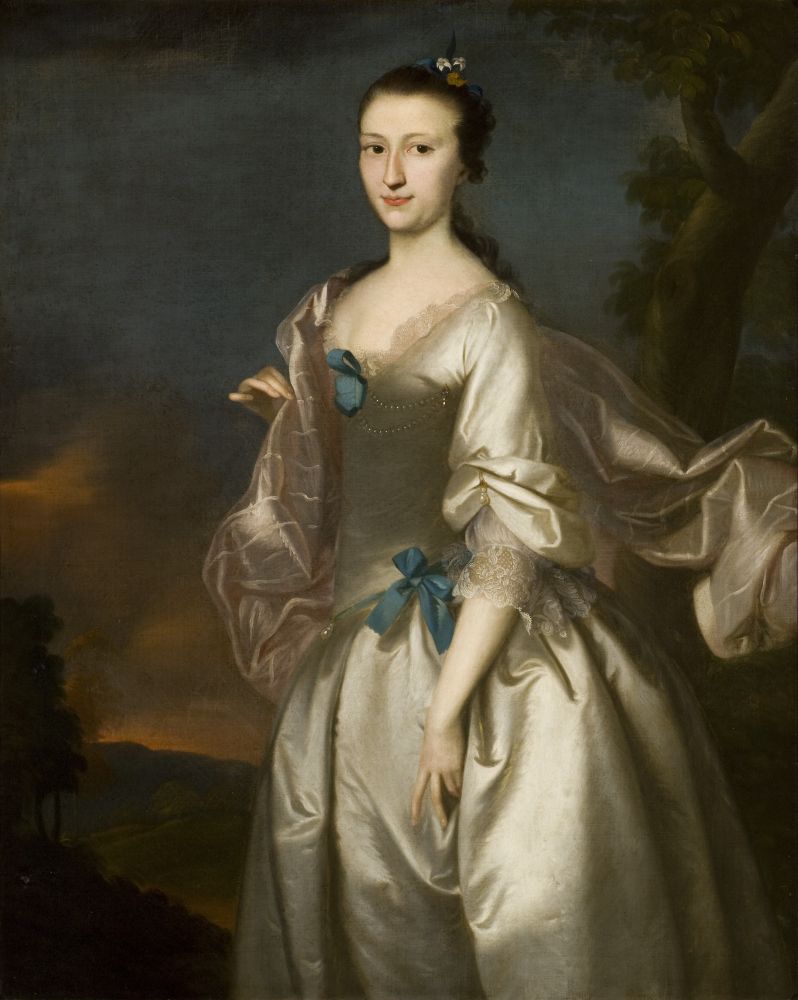
Fig. 5. Joseph Blackburn, Elizabeth Browne Rogers. 1761. Oil on canvas. Courtesy, Reynolda House Museum of American Art, Winston-Salem, North Carolina.
In reality, her future quickly soured. Shortly after the portrait was completed, Rogers left his wife to join a campaign against the Cherokees in South Carolina. Elizabeth remained in New Hampshire with her parents for the next five years, during which time rumors circulated of Rogers’s drinking and philandering.19 By 1763 Rogers was back in the contested theater of the Great Lakes region, fighting in Pontiac’s War. Then, in 1766—having sailed to England with Elizabeth in a vain attempt to persuade King George III to sponsor an expedition in search of a northwest passage—he obtained the command of Fort Michilimackinac, a former French trading post located on a strait between Lake Michigan and Lake Huron. Elizabeth, reared in the genteel surroundings of Portsmouth, joined her husband there. But not for long: Roberts was arrested on charges of treason and sent north to Montreal—now part of the British empire—for trial. He was found innocent, but he was disgraced and unemployable, and so he fled, alone, back to England, where he was thrown into debtor’s prison. Bonded out by a sibling, Rogers salvaged his reputation by publishing two narratives of military life in America and a lurid play about Pontiac entitled The Savages of America20 He returned to the colonies in 1775, where, in the thick of mounting anti-British tensions, he aroused the suspicion of George Washington. Discerning Rogers to be a spy for the crown, Washington returned him to jail. But the ever resourceful Rogers escaped, and soon he was commanding a Loyalist regiment called the Queen’s American Rangers which engaged in combat and finally met defeat near White Plains in New York.21
How did Elizabeth Rogers respond to her husband’s exploits? Much as any long-suffering wife might: in 1778, she divorced him. It thus seems woefully ironic that the only known image of her should be a marriage portrait. Painted by Blackburn, who came to Boston from England in 1755, the portrait represents Elizabeth as a proper Englishwoman. Blackburn’s ability to fashion colonial sitters in this manner was precisely what made him attractive to his provincial audience. Blackburn was no master of psychological introspection (indeed, his subjects’ facial features look very similar from one canvas to another). Rather, his emphasis was on the outward display of the polite body, on the appearances of the luxury goods that elite Anglo creoles donned to make themselves look more British. Recognized for introducing Rococo style and the English pictorial convention of the “conversation piece” to the British colonies, Blackburn excelled in the mimetic imitation of material stuff: the lustre of silk, the gleam of gold buttons, and the delicate intricacy of expensive lace.22 Thus when families such as Elizabeth Browne’s commissioned Blackburn to paint family portraits, they weren’t just employing the latest painter from England. They were deliberately cultivating an association with a distant place across the Atlantic, staking—through costume, pose, and pigments—their place within the British empire.
This is not an especially original observation. Historians of art and material culture have long observed that British colonists imported English goods and imitated English fashions in an effort to retain (or outright invent) a cultural relation to the imperial metropole. If Blackburn’s portrait helps support this understanding of a transatlantic connection, however, it also possesses the potential to trouble this linear equation. For the picture not only refers us across the Atlantic Ocean to London: it also invites us to consider New England’s relation to other places. One of those places is the Caribbean. Before Blackburn arrived in the Boston area, he spent two years painting royal appointees and plantation owners in the British colony of Bermuda. Many European artists passed through the Caribbean on their way to the northern colonies, in part because they had booked passage on ships that followed the trade routes. But the significance of Blackburn’s presence in Bermuda has been overlooked—or more accurately, grossly under-appreciated—in scholarship about eighteenth-century American painting. Blackburn’s Caribbean sojourn compels us to reevaluate the pictorial evidence that suggests New Englanders wanted to cultivate associations with England. What if Blackburn’s Bermuda work was just as important to them? What if the cultural world in which they framed their sense of selfhood included the powerful planters of the Caribbean colonies.23 Historians and literary scholars have done much within recent years to recognize the centrality of the Caribbean within the development of North America. Scholars of visual culture may likewise discern new significance in New England objects—like Blackburn’s portrait of Elizabeth Browne Rogers—by triangulating immigrant artists and their sitters within a system of empire that included Bermuda and other Caribbean islands.
And what of the fate of the portrait itself? Did it accompany Elizabeth when she went to live at Fort Michilimackinac, some thirteen hundred miles from Portsmouth? If so, what did the varied populations of people there—British officers, French traders, and Indian visitors—make of it? Michilimackinac was both a military and commercial post; it controlled the lucrative fur trade of the entire region, connecting the Great Lakes to Montreal and points east and overseas. However removed, then, from the busy seaports of eastern colonies or the counting houses of London, this inland fort was nonetheless integral to the operations of the British empire, as vital to the control of commerce and land as the Caribbean plantations that exported slaves, sugar, and rum. Whether or not Blackburn’s portrait made the trip from Portsmouth to Michilimackinac, the picture implicitly references a network of far-flung people and places through its painterly facture and imagery. It helps demonstrate how material culture could link the disparate regions of the British Atlantic world.
In closing, I turn from object lessons to lessons learned in the classroom. In 2007 and 2011, I collaborated with a University of Delaware colleague—Professor Monica Dominguez Torres, a specialist in colonial Spanish art—on the design and implementation of seminars on art across colonial North America. The courses took a wide and comparative view of early North America, exploring issues of cultural hybridity and material exchange in New Spain, New France, and British America. From the outset, the students were tasked with exploring how objects produced New World cultures: how trade brought diverse cultures into contact with one another; how objects linked places as diverse as New Orleans and New Amsterdam; and how the material evidence of objects posed challenges to familiar histories of colonial conquest and settlement. One class assignment involved conceptualizing a mock exhibition that illustrated the dynamism of early North American material culture through the study of places that were significant as colonial cultural entrepôts. Working in groups, the students focused upon four examples: California missions; late-eighteenth-century New Orleans; Cuba, Barbados, and Curaçao in the West Indies; and Salem, Massachusetts. To exemplify the material culture of the latter city, the Salem group selected a diverse range of artifacts, including a decorative sugar box made of silver mined in Mexico; a figurehead from one of Salem’s fleet of merchant vessels; and a Federal armchair from the Winterthur Museum that reads like an index of international trade. According to Sarah Jones, the student who studied this chair, the design is English, from George Hepplewhite’s Cabinet-Maker and Upholster’s Guide (London, 1788), yet also resembles chairs being produced in Portsmouth, New Hampshire, and Baltimore, Maryland. It was made by an unknown Salem craftsman who combined local secondary woods with mahogany from the West Indies. And it features a shellac-based finish composed of ingredients from Asia and the Mediterranean. As Ms. Jones rightly concluded then, this chair is much more than an example of regional furniture production: it embodies the expansion of global trade in the United States about 1800, in terms of materials as well as the dissemination of design sources. In this New England chair, there is a bit of Old Europe, a lot of the Caribbean, and even parts of the distant Pacific.
As scholars and educators, we have the opportunity to convey the excitement of studying visual and material culture to those whom we mentor and teach—to encourage our students, interns, and advisees to put original questions to the stuff of history. The Salem armchair suggests the rewards of following new approaches. Like Blackburn’s portrait and the Invisible Lady, the chair points at once toward the past and toward the future. As it manifests the formation of an Atlantic culture in wood and varnish, it also compels us to look beyond the borders of New England in order to understand the nature and consequences of that formation. That’s a lot for a chair to do. The rest is up to us.
